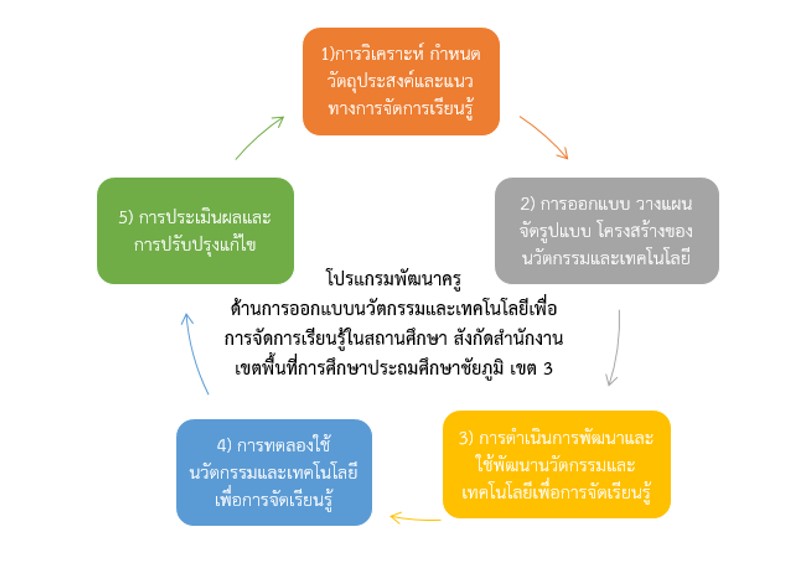DEVELOPMENT A PROGRAM TO ENHANCE TEACHER’S INNOVATIVE AND TECHNOLOGIES DESIGN FOR LEARNING OF SCHOOL UNDER THE OFFICE OF CHAIYAPHUM PRIMARY EDUCATIONAL SERVICE AREA 3
Main Article Content
Abstract
This research the objectives are 1) to study the current condition Desirable conditions and necessities of teacher development in innovative design and technology for learning management in educational institutions. Under the Office of Chaiyaphum Primary Educational Service Area 3 2) To develop a teacher development program on innovative design and technology for learning management in educational institutions Under the Office of Chaiyaphum Primary Education Service Area 3, the sample group consisted of 310 teachers, 3 schools with excellent practice, and 5 qualified experts assessing the suitability and feasibility of the program. The research uses were questionnaires, semi-structured interviews. Program feasibility and feasibility assessment form. The statistics used in the data analysis were percentage, mean, standard deviation. Conformity Index Value Pearson's correlation coefficient Cronbach's Alpha Coefficient and the need to prioritize the index value
The results of the research were as follows: 1. The current state of innovative design and technology for learning management in educational institutions. Under the Office of Chaiyaphum Primary Educational Service Area 3, the overall level was at a high level. and desirable conditions in innovative design and technology for learning management in educational institutions Under the Office of Chaiyaphum Elementary Education Service Area 3, the overall level was at the highest level. 2. Teacher development program in innovative design and technology for learning management in educational institutions under the Office of Chaiyaphum Elementary Education Service Area 3 consist of: 1) Principles 2) Objectives 3) Content is divided into 5 modules and teacher development method, model 70:20:10. The development method consists of meetings, workshops. follow-up supervision learning from practice and self-study 4) program process 5) evaluation results of assessment of the feasibility and feasibility of the overall program It is appropriate and feasibility is at a high level.
Article Details

This work is licensed under a Creative Commons Attribution-NonCommercial-NoDerivatives 4.0 International License.
References
กระทรวงศึกษาธิการ. (2542). พระราชบัญญัติการศึกษาแห่งชาติ พุทธศักราช 2542. กรุงเทพมหานคร : โรงพิมพ์คุรุสภาลาดพร้าว.
กิดานันท์ มลิทอง. (2551). เทคโนโลยีการศึกษาร่วมสมัย. พิมพ์ครั้งที่ 2. กรุงเทพมหานคร : เอดิสันเพรสโพรดักส์.
ครรชิต มาลัยวงศ์. (2535). คอมพิวเตอร์กับการศึกษา สวัสดีครับคุณครูคอมพิวเตอร์. แมกกาซีนคอมพิวเตอร์. 1(4). 48-51.
ณัฐพงศ์ แก่นสา. (2560). โปรแกรมพัฒนาครูด้านเทคโนโลยีเพื่อการศึกษาสำหรับสถานศึกษา สังกัดสำนักงานเขตพื้นที่การศึกษาประถมศึกษาร้อยเอ็ด เขต 2. วิทยานิพนธ์การศึกษามหาบัณฑิต. บัณฑิตวิทยาลัย : มหาวิทยาลัยมหาสารคาม.
ทวี จันทร์เติม. (2561). การพัฒนาโปรแกรมพัฒนาครูด้านการออกแบบนวัตกรรมและเทคโนโลยีเพื่อการจัดการเรียนรู้ของสถานศึกษาสังกัดองค์กรปกครองส่วนท้องถิ่น. วิทยานิพนธ์การศึกษามหาบัณฑิต. บัณฑิตวิทยาลัย : มหาวิทยาลัยมหาสารคาม.
ราชกิจจานุเบกษา. (2562). ข้อบังคับคุรุสภา ว่าด้วยมาตรฐานวิชาชีพ (ฉบับที่ 4) พ.ศ. 2562. (20 มีนาคม 2562) เล่ม 136 ตอนพิเศษ 68 ง.
วันเพ็ง ระวิพันธ์. (2556). แนวทางด้านการออกแบบนวัตกรรมและเทคโนโลยีสารสนเทศด้านการจัดการเรียนรู้ของครูตามนโยบายไทยแลนด์ 4.0 สำนักงานเขตพื้นที่การศึกษาประถมศึกษาพระนครศรีอยุธยา เขต 2. วารสารครุศาสตร์ปริทรรศน์ คณะครุศาสตร์ มหาวิทยาลัยมหาจุฬาลงกรณราชวิทยาลัย. 6(1). 116-129.
วิจารณ์ พานิช. (2555). วิถีสร้างการเรียนรู้เพื่อศิษย์ในศตวรรษที่ 21. กรุงเทพมหานคร : มูลนิธิสดศรี-สฤษดิ์วงศ์.
สำนักงานเลขาธิการคุรุสภา. (2555). คู่มือการปฏิบัติงานการต่อใบอนุญาตประกอบวิชาชีพทางการศึกษา. กรุงเทพมหานคร : สำนักงานเลขาธิการคุรุสภา.


